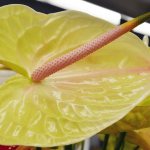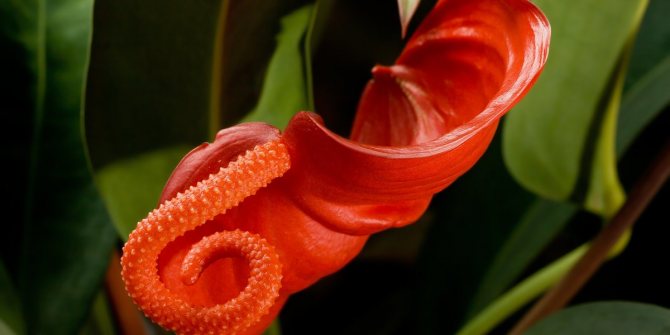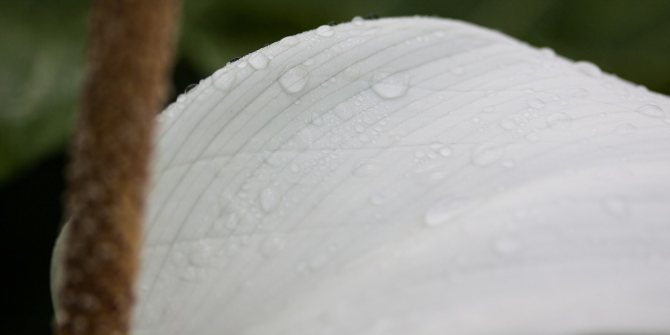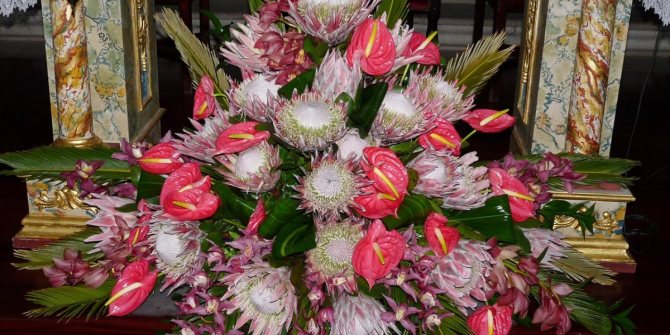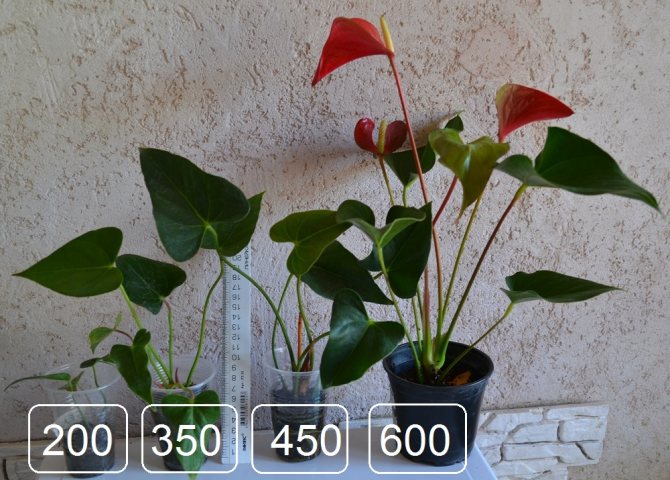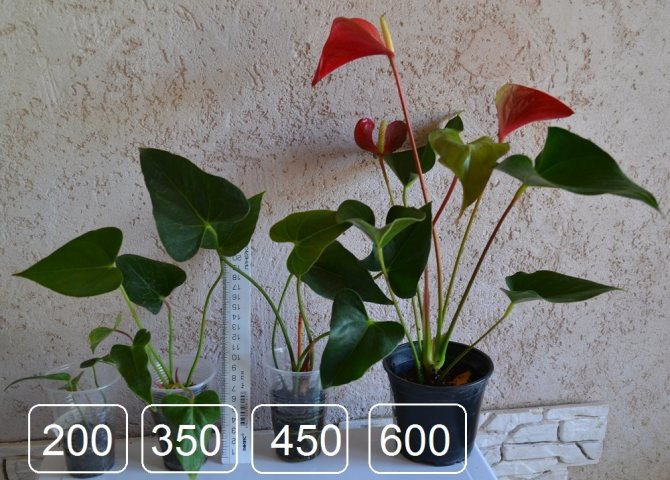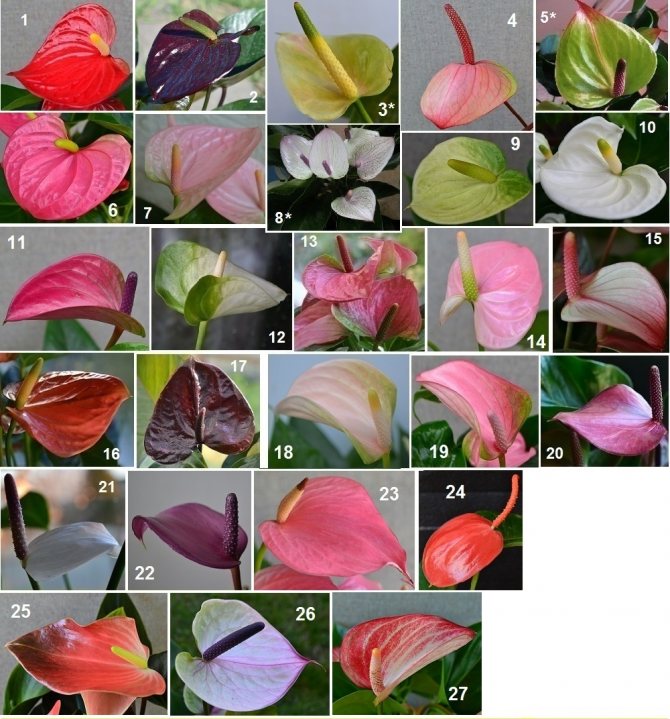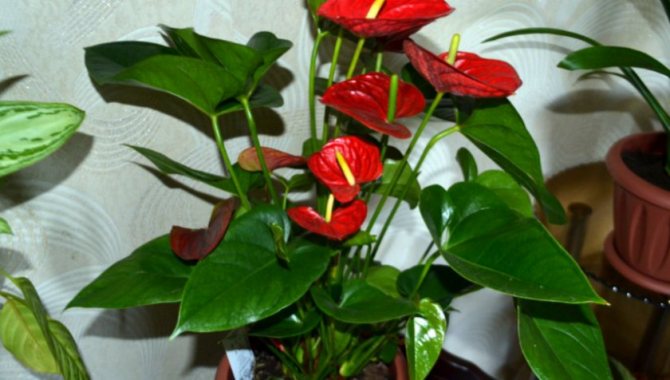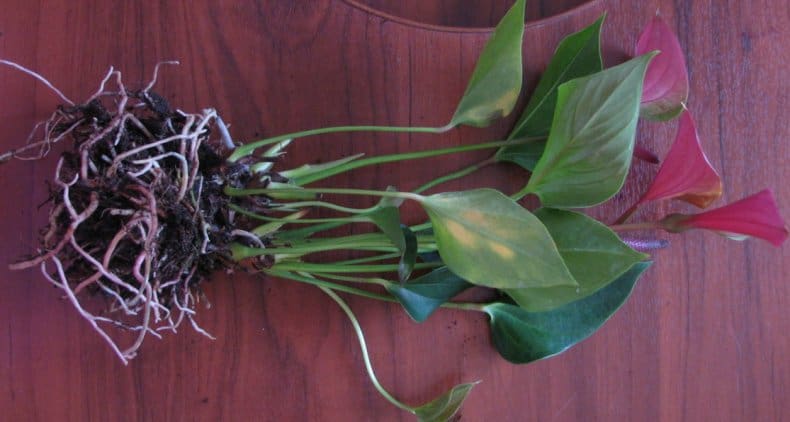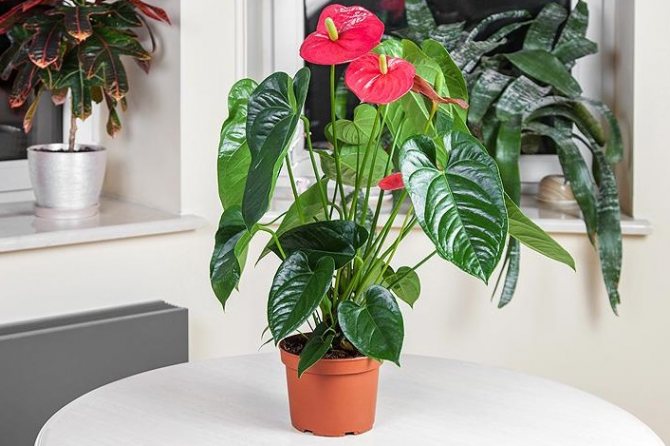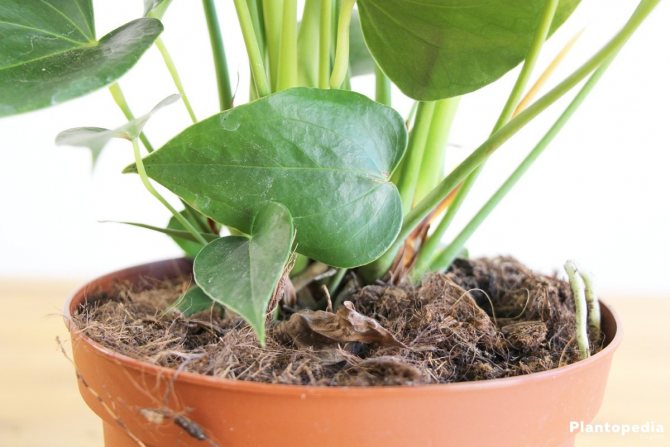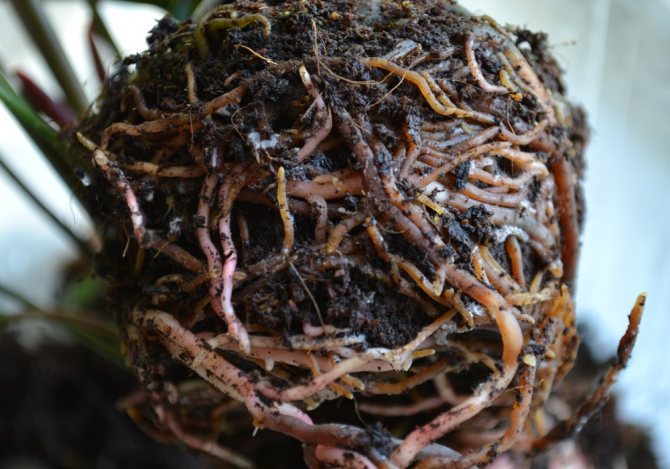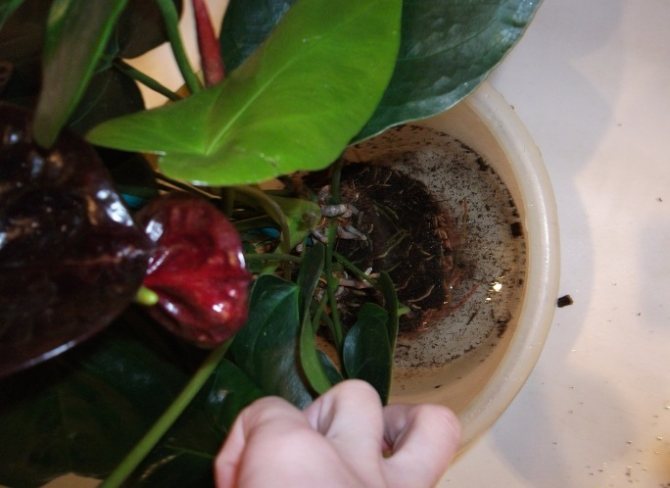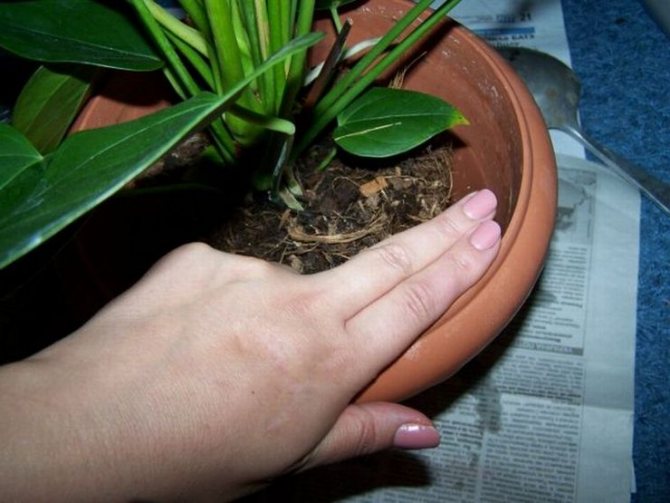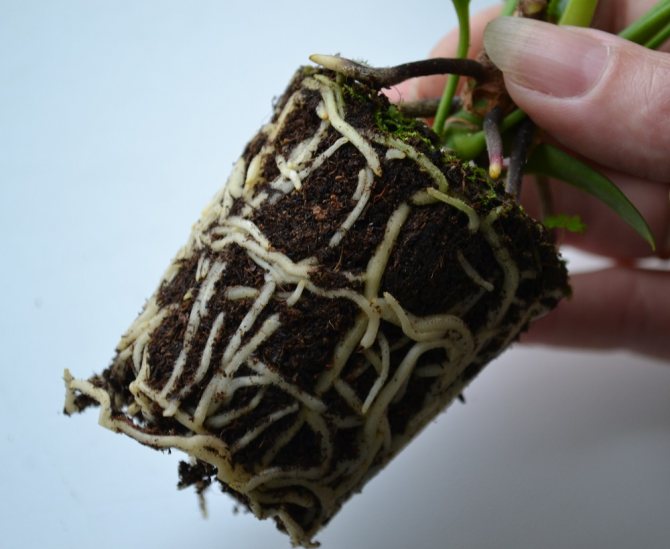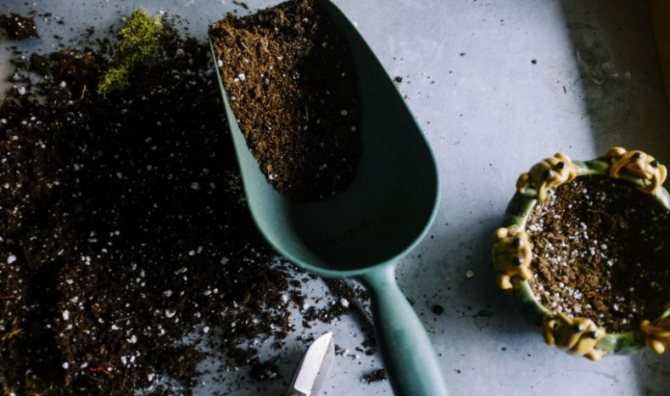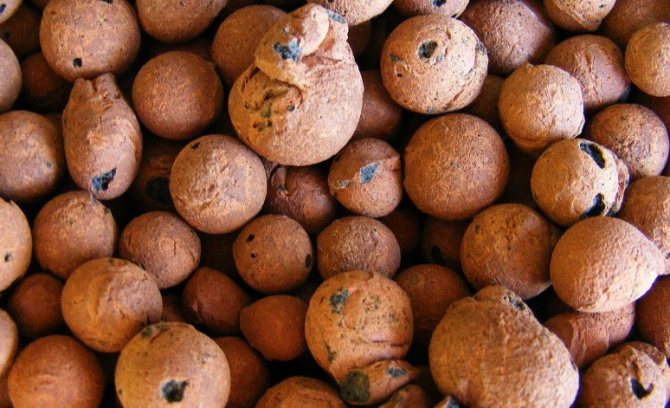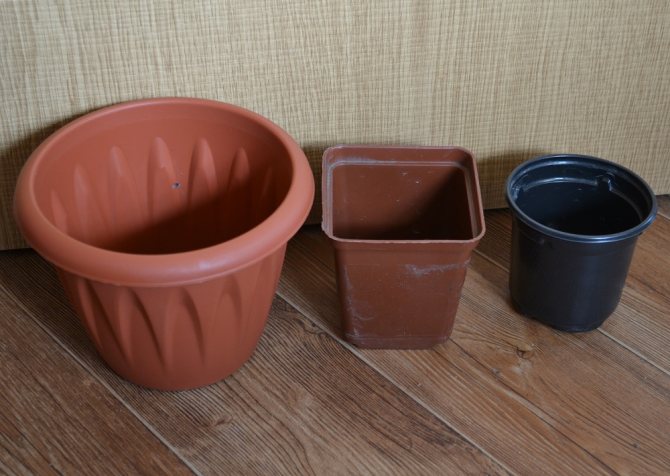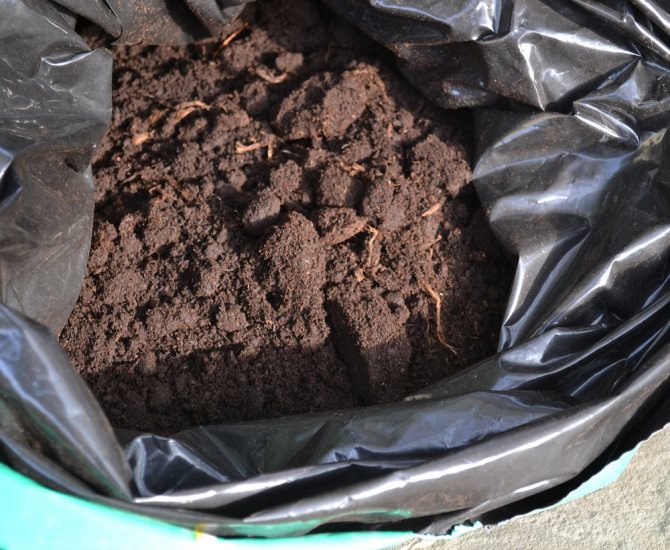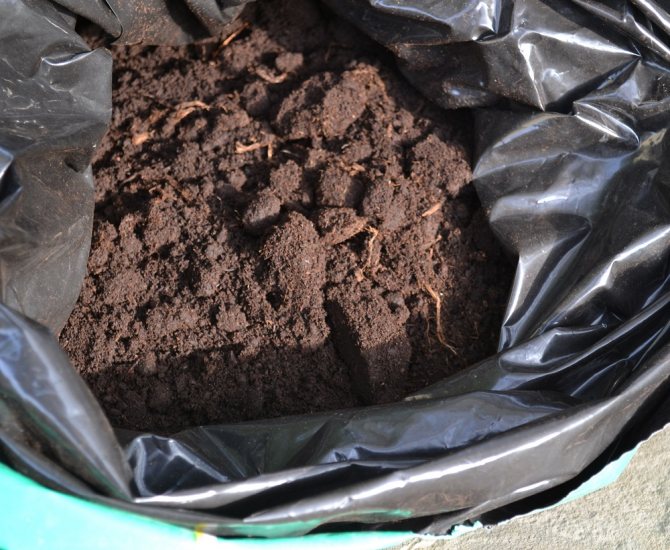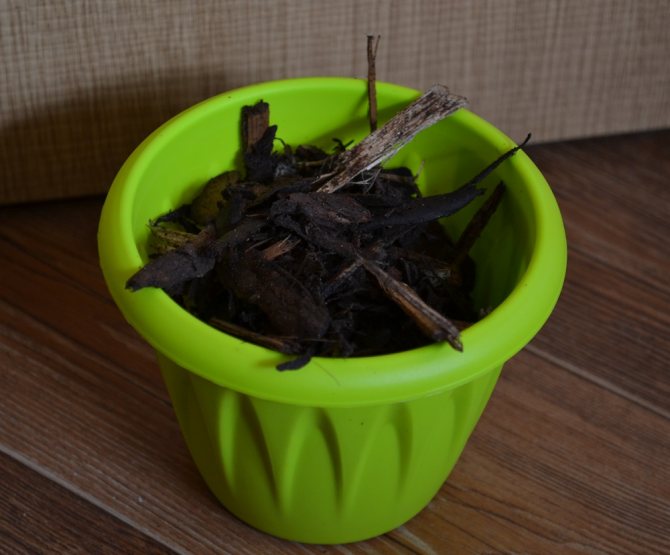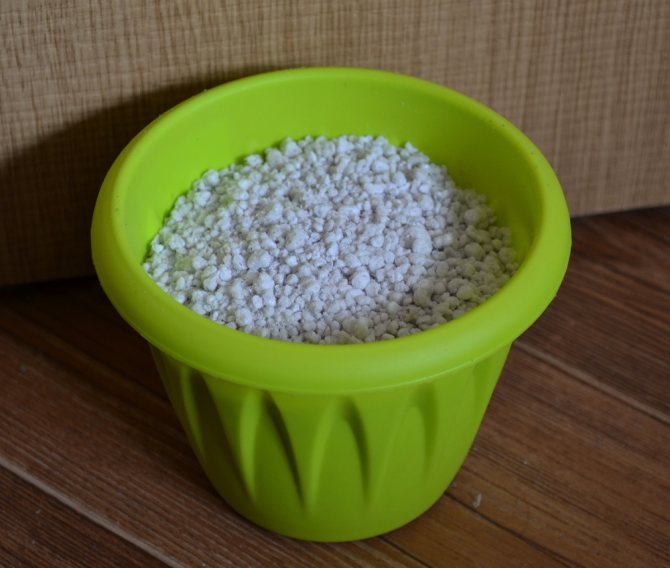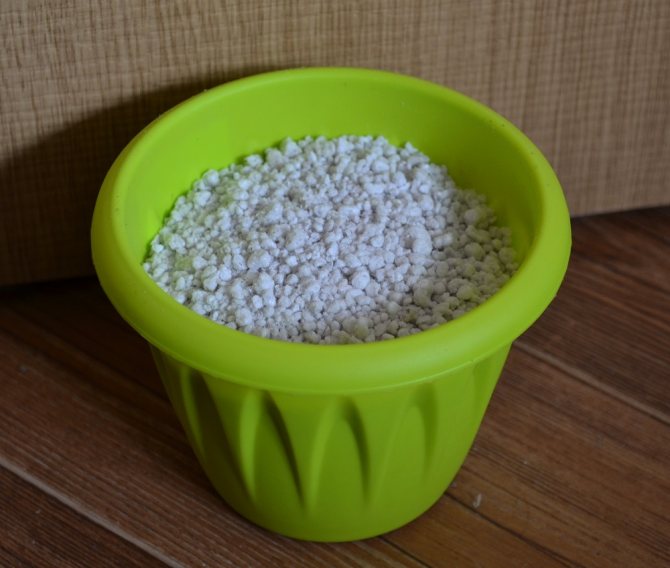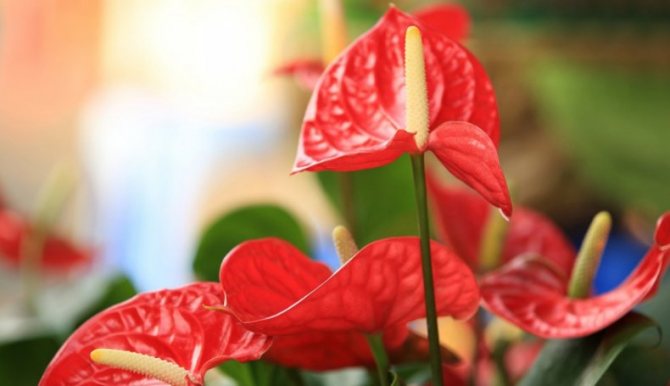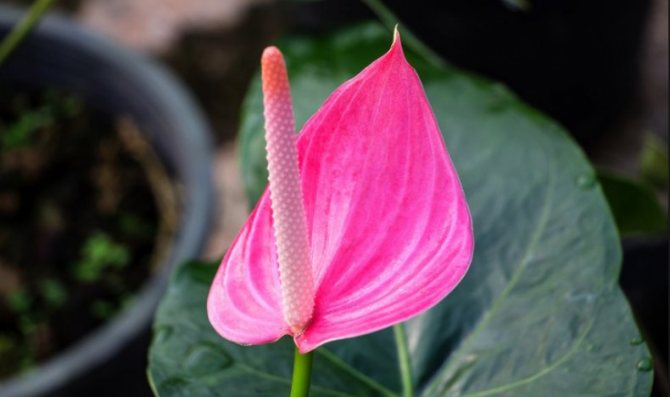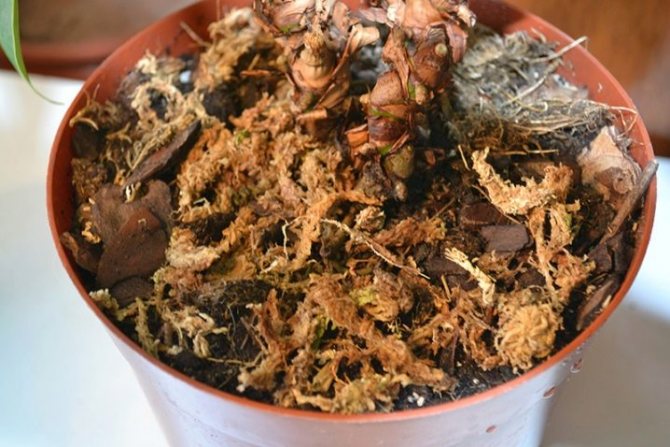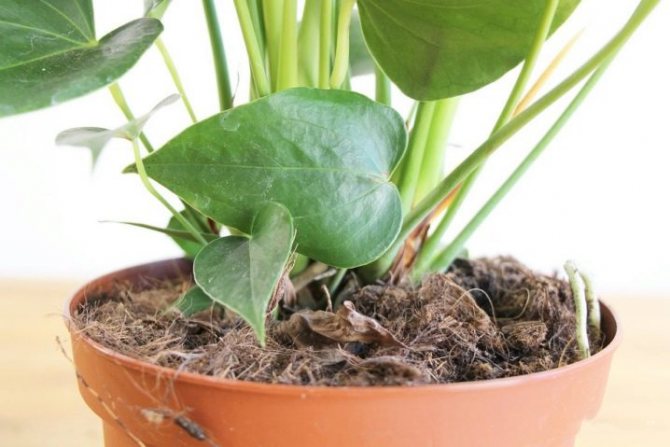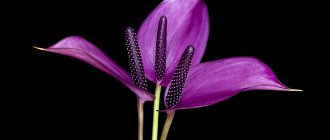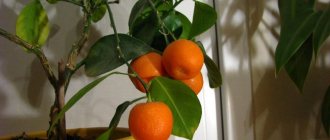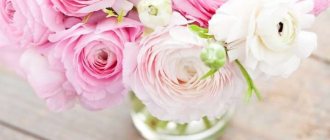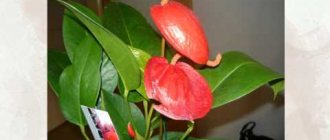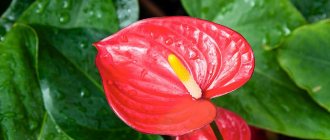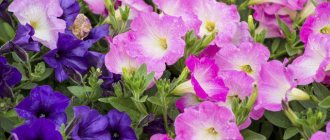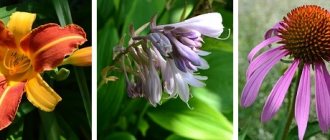Anthurium, like any other house plant, periodically requires a transplant. He transfers it quite easily, even in a flowering state, so this manipulation can be done if necessary at any time of the year. For example, with rotting roots, the transplant will have to be performed urgently. If you have just bought an anthurium, a transplant may also be needed quite quickly, for example, if the plant is flooded or the soil is not suitable. When purchasing anthurium from a well-known supplier, you can take your time with a transplant and perform it after acclimatization or even after the roots have completely mastered the soil in a pot.
Brief description of the flower
Currently, more than 30 species and a huge number of anthurium hybrids are known with the most varied color of leaves and flowers. Depending on the variety, the height of the flower ranges from 40 to 80 cm. The dark green shiny foliage is round or heart-shaped and has long petioles. In some species, it can be decorated with a different pattern of veins.

In addition to the common red and pink colors, anthurium can be yellow, orange and even blue!
The flowers of the plant look like the original inflorescences, consisting of a white, yellow or pink ear, which has a straight or spiral shape. It is surrounded by a dense red, bright pink, yellow, burgundy or purple pointed bedspread with a wax coating. The flowers themselves can reach 10 to 20 cm in diameter. With the right conditions and good care, anthurium blooms almost all year round.
All parts of the flower are poisonous, so you need to place it in places that are inaccessible to small children and pets to avoid poisoning.
Choosing the right soil for anthurium
Anthurium is an unusual flower native to South and Central America. Its bright, heart-shaped flowers against the background of large bright green, as if covered with wax, leaves will not leave anyone indifferent.
The originality of the plant is given by the shape of the flowers - a narrow ear is surrounded by a bracts, painted in white, red, pink or purple. The flower is popularly known as "male happiness".
It is important to take into account that anthurium is a tropical plant and at home it is an epiphyte or semi-epiphyte. He needs appropriate conditions, in particular, a properly selected earthen mixture, and what kind of soil is needed for anthurium, we will now tell you.
If you plant it in ordinary soil, the roots will have nothing to "breathe", and the plant will quickly lose its attractiveness, stop blooming and may soon die. Therefore, the right choice of land is the key to good growth and flowering of anthurium. But what mixtures are suitable for this exotic? And how to prepare them correctly?
Transplant reasons
Young anthuriums are transplanted, as a rule, annually due to active growth. Since the flower has a very fragile root system, adult plants are transplanted once every few years as needed.


Do not assume that the thickened anthurium will bloom profusely. Not at all, the flowers will be small, and the plant itself will lose its original appearance.
The fact that the plant needs a transplant may be indicated by the roots emerging from the drainage holes, or a white coating on the soil, indicating its severe depletion.
Since anthurium blooms most of the year, its transplant can be carried out from mid-spring to early autumn at the time of the break in flowering. During the work, you need to use household gloves and make sure that the flower juice does not get on the mucous membrane of the eyes. If this does happen, you must urgently rinse them with cold water.
Features of growing a flower
When choosing a flower, it is important to pay attention to the fact that the leaves must be beautiful and shiny. A blooming indoor flower should not have brown-spotted ears. In order for the flowers to grow and also bloom, it is well recommended to observe the following growing rules:
- it is recommended to grow indoor plants on well-lit windowsills, but without direct sunlight. If your windows are on the south or west side, shade the flower;
- anthurium needs sufficient moisture. If there is no humidifier, place a tray of pebbles near the pot and moisten it constantly;
- in the summer, some growers put the plant pot in a large container of pebbles. The space between the walls is filled with moss or peat;
- the leaves of the plant need daily spraying with water and a drop of vinegar.
In order for the soil for anthurium to be sufficiently nutritious and at the same time without frills, it is recommended to feed it with complex fertilizers intended for flowering plants.
Is it worth replanting after purchase
All plants purchased from specialized stores are grown in transport soil, which does not contain any nutrients. Therefore, after purchase, anthurium must be transplanted into specially prepared soil.
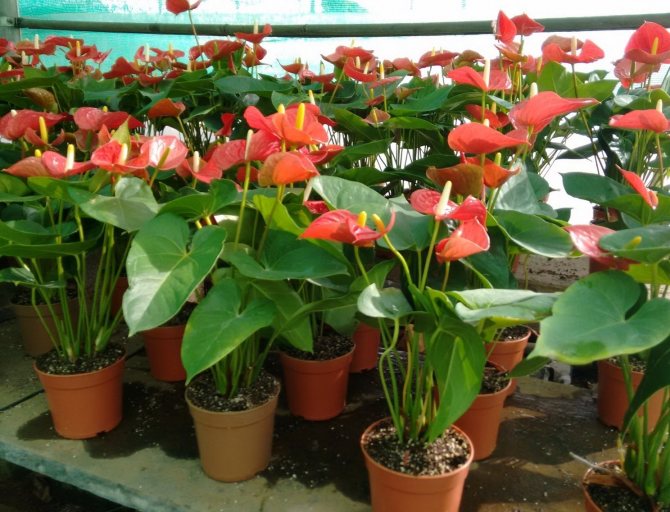

Amateur flower growers recommend replanting the flower immediately, because a beginner is unlikely to be able to provide it with the microclimate that florists create in the store. Therefore, without a transplant, a young plant dies in a week or two.
You do not need to do this immediately after purchase, the plant should get out of the stressful situation that it endures during transportation and get used to a new place of growth.
Having brought anthurium home, you need to quarantine it for several weeks. The flower should be placed separately from other plants and watched. Perhaps during this time, signs of a disease or pests that could not be found during purchase will be found. If this happens, then the anthurium must first be treated, and only then placed next to the rest of the plants, choosing a permanent place of growth for it.
It is advisable to transplant the purchased anthurium within the recommended time frame. But if the flower is too crowded in the transport pot or it looks too depressed due to lack of nutrients, then you can deviate from this condition and carry out an unscheduled transplant. At the same time, you need to know that you cannot transplant the plant during flowering, you need to wait until it ends. If new buds appear, they must be removed immediately.
Useful Supplements
The substrate for planting anthurium should contain large non-degradable particles. They significantly reduce the density of the soil and increase its ability to pass air and moisture. This serves to prevent root decay.
Broken brick, pieces of charcoal, perlite, vermiculite, pine bark are used as such additives. These components should make up 15% of the total volume of the earthen mixture.
Perlite - small pebbles or grains that increase the moisture holding capacity of the substrate. Vermiculite - crushed mineral in the form of medium-sized scales.
Gives the soil lightness, flowability and moisture capacity.Charcoal acts as an antiseptic and also absorbs excess moisture and unpleasant odors.
By choosing the right substrate, you can grow exotic anthurium, which will fill the house with bright colors and positive emotions!
Did you like the article? Share it with your friends on social networks:
How to transplant a healthy anthurium
To transplant a healthy anthurium, you need to prepare a new pot, the diameter of which should be about 3 cm larger than the previous one. For tall plant varieties, it is recommended to purchase ceramic containers, since they are much more resistant than plastic ones. In addition, they are more environmentally friendly. Anthurium has a shallow root system, so it requires a low but wide pot. If initially there are no drainage holes in it, they must be made.
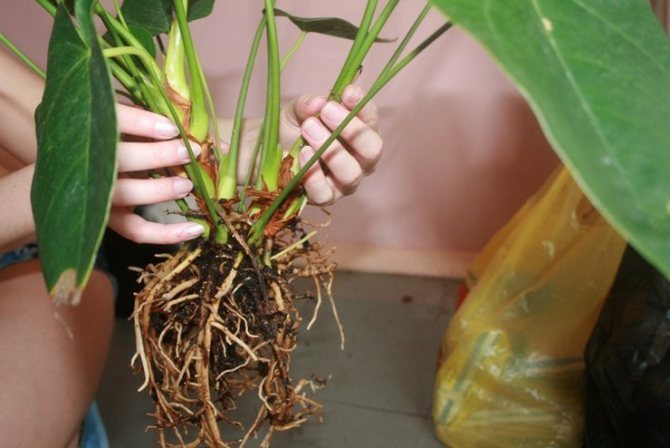

For better rooting and disinfection, amateur flower growers use not only activated carbon, but also cinnamon in powder form
For anthurium, a light, loose, moisture- and air-permeable soil with a slightly acidic reaction is preferable. If ready-made substrates are used, then you should choose those in which azaleas, orchids or bromeliads are planted. You can also prepare a nutritious potting soil mixture for transplanting yourself. To do this, it is recommended to use the following components:
- Leafy land - 2 parts, sod land - 1 part, sphagnum moss - 1 part, coarse sand - 1 part;
- Sod land - 3 parts, humus - 3 parts, pine bark - 1 part, coarse sand - 1 part, perlite - 1 part;
- Sod land - 2 parts, peat - 3 parts, humus - 1 part, coarse sand - 1 part.
Experienced flower growers advise adding crushed charcoal to the soil. The prepared substrate must be sterilized to eliminate bacteria and pests. This can be done by heating it for several hours in the oven at 80 ° C. After that, you can additionally spill it with a weak solution of potassium permanganate or fungicide and dry it.
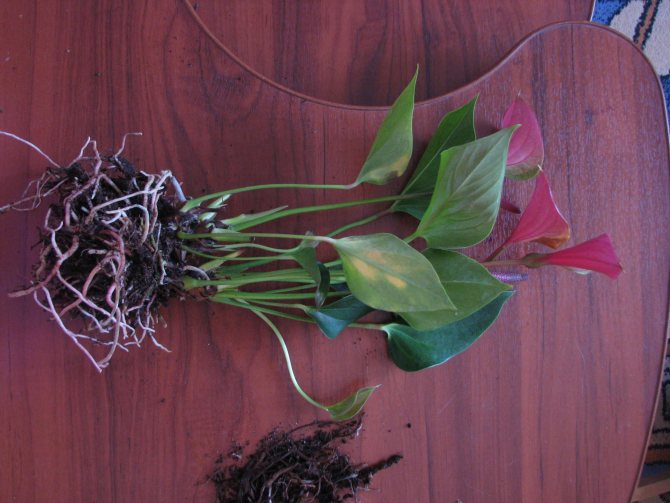

It is recommended to rinse the roots with water, separated for at least 2 days.
In order for the transplant to be successful, you should use the following method:
- The day before the scheduled procedure, the anthurium is watered abundantly and dried and old leaves are removed from it.
- The prepared pot is covered with drainage by a third.
- A small amount of the substrate is spread over the drainage layer.
- The flower is carefully pulled out of the old container, while unnecessarily it is not necessary to completely clean the roots from the soil so as not to damage them.
- The plant is placed in a new pot, covered with soil and lightly compacted.
- After the completion of the process, the anthurium is well watered. In the future, very moderate watering should be carried out throughout the month in order to prevent decay of the weakened plant.
- If the anthurium transplant is carried out correctly, then it grows very quickly and blooms profusely.
Tillage
The components that are used to prepare the soil mixture must undergo preventive treatment. This is due to the fact that they can contain pests, their larvae and eggs, imperceptible at first glance.
But over time, they can bring a lot of problems for the anthurium. In addition, the soil can contain spores of fungi that cause various plant diseases.
There are several ways to cultivate the land.:
- Pour the earthen mixture onto a metal baking sheet. The layer should be no more than 5 cm. Place the baking sheet in an oven preheated to 80 degrees for 70-90 minutes;
- You can steam the soil. For this, a bucket or other large container is put on fire and brought to a boil. On top of the lattice, put the earth, previously wrapped in cloth. The procedure lasts 90 minutes;
- Pour soil onto a pallet so that the layer is no more than 7 cm.Expose to frost, not warmer than -7 degrees, and freeze it for 3-4 days;
- Spill the earthen mixture with a weak solution of potassium permanganate (3 grams per 5 liters of boiling water). Wait until the ground cools down to room temperature - and you can start planting or transplanting anthurium;
- Use biological fungicides such as Fitosporin, Fitop, Integral, Trichodermin, Agate. Dosage - according to the instructions. The beneficial bacteria that these preparations contain destroy the pathogenic bacteria and fungi present in the soil.
Not all compound soil mixtures should be sterilized, but only the most "dangerous": turf, leaf, coniferous land, humus. Peat and sphagnum moss are added after the disinfection procedure. So the microflora of the soil will be restored much faster.
How to work with a heavily overgrown flower
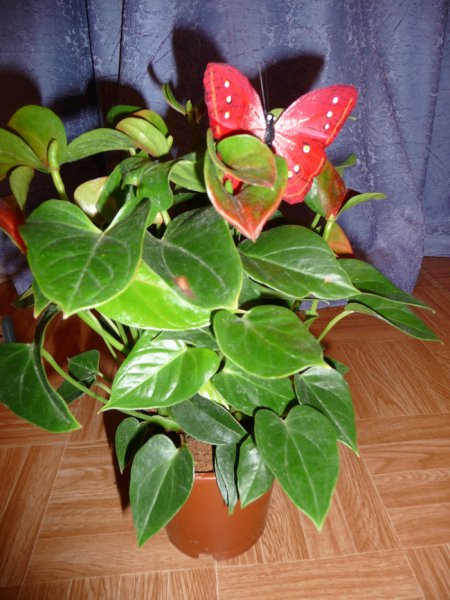

If there is not enough space for the roots of anthurium, it is unlikely to please with lush flowering.
If an adult anthurium has not been transplanted for several years, then it can grow greatly. At the same time, its leaves and flowers are significantly smaller, which reduces its decorative qualities. Therefore, when transplanting it, it is recommended to divide the bush. In this case, the remaining divisions can be used for vegetative propagation. To correctly transplant an overgrown plant, you need:
- Carefully remove the anthurium from the pot. If this fails, you will have to cut, break or break the container, trying not to touch the roots.
- The root system must be cleaned of soil as much as possible, rinsed and damaged and dried out areas removed.
- With a sharp disinfected knife (for example, rubbed with alcohol), divide the plant into several parts. Moreover, each division must have a sufficient number of roots and a growth point.
- Sprinkle all the cut sites with crushed activated carbon and allow to dry a little.
- For each part of the anthurium obtained, you need to prepare a separate pot of the appropriate size with drainage and a nutritious soil mixture.
- Plant the delenki in prepared containers and moisten well.
- Transplanted young plants should be placed in a warm and slightly shaded rooting room for several weeks, with moderate watering as needed.
- After transplanting, it is recommended to cover very small divisions with glass jars to create a special microclimate that will improve rooting. They must be removed daily for ventilation, condensation evaporation and humidification when required.
- When the anthurium seedlings take root and new leaves begin to develop in them, they are rearranged to a permanent place, feeding and further care for them, as for adult plants.
Video on carrying out work to help a beginner
Reproduction methods


There are several ways to grow this species at home and reproduce it. Each has its own rules of conduct, which must be strictly followed.
How anthurium reproduces at home:
- dividing the bush, this method is the most popular and simplest. When transplanting anthurium, the plant is divided into several parts and planted in new pots.
- by rooting a leaf, a part of the stem with a leaf is separated from an adult plant, dropped into the ground, watered, covered with a cap until roots appear;
- by cuttings, in this case, the young shoot of the plant is separated, placed in water or dropped into the ground until roots appear;
- seeds, this method is considered the longest.
The easiest way to get new plants is to split the mother bush into several parts when transplanting into a new pot. When a plant is planted, you need to protect its root system (it is advisable to separate it with your hands).
Reproduction of anthurium by cuttings is as follows:
- You need to cut off a leaf with a stem about 7 cm long.
- The cut is dried for a while, after which it is placed in water (it can be rooted in the soil).
- Cover the stalk with a bag and leave in a warm place.
- You can plant in a pot after about a week, when the roots grow up to 2-3 cm.
Reproduction and planting with a leaf is only suitable for certain varieties of anthurium, for example, “Andre”. It is necessary to cut off the leaf correctly with a petiole of 3 cm. After that, the leaf is folded into a tube, which is fixed with an elastic band. To root a leaf, it is planted in the ground, leaving only 1/3 of it on the surface. It must be planted under a glass jar, away from direct sunlight, ventilated and sprayed daily. Three weeks after that, a young plant will appear, and a month later, when it gets stronger, you can plant it in a pot.
Sometimes planting is done by seed. The method is complex and time consuming, but it is he who allows you to breed unique plant varieties. The seeds are bought in stores or grown on their own. Seeds are planted in peat under a special cap. After the appearance of the third leaflet, the protection is removed.
You can get seeds yourself. To do this, when anthurium blooms, it is necessary to pollinate with a cotton swab or brush, holding it over the cob. The best option would be to use pollen from not one, but two plants, since cross-pollination gives a better result. The whole procedure is carried out within a few days - two or three times.
After pollination, it is necessary to wait until the berries that appear on the cob ripen, and this process lasts about a year. Ripe seeds are cleaned of pulp and planted in a prepared substrate. They are placed on the surface of the substrate, and the dishes are placed in a warm place. Seeds sprout in the period from 7 to 16 days. Anthurium grown from seeds will bloom only in the third year.
How to help a diseased plant
If kept incorrectly, for example, with frequent overflows or low temperatures, anthurium can be infected with a number of bacterial or fungal diseases (fusarium, gray and root rot, and others). Some of them affect not only the terrestrial part of the plant, but also spread to the root system.
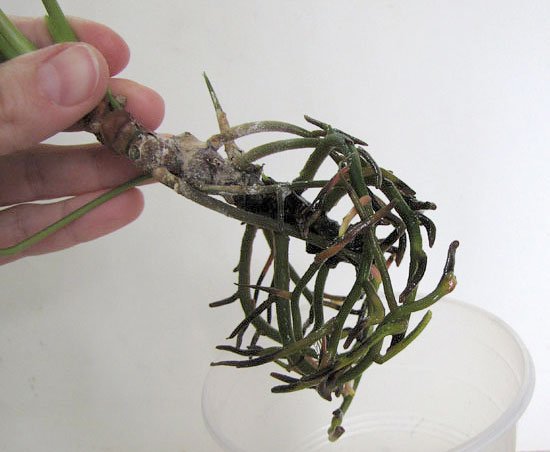

Root rot affects anthurium with inept watering or improperly selected drainage
Therefore, a diseased plant often requires a transplant with root treatment and complete soil replacement. If signs of a disease are found, it is urgent to transplant the anthurium, regardless of the season and flowering, since otherwise the plant can quickly die. In order to transplant a sick flower, you should:
- Prepare a new pot, drainage, sterilized soil, activated carbon and fungicide solution.
- Remove all diseased leaves and stem parts from the plant, if any.
- It is recommended to sprinkle the cut sites with crushed activated carbon.
- Remove the anthurium from the planting container and very carefully clean it from the soil.
- Rinse off the rest of the soil from the root system with warm water.
- Examine the roots, remove dried and rotten parts and place the plant for half an hour in a container with a weak solution of potassium permanganate for disinfection.
- Place the treated anthurium in a new pot with a drainage layer and sterilized soil and cover it with a substrate.
- After the end of the transplant, water the plant with a fungicide solution. This watering is recommended to be carried out weekly for a month.
How to give a second life to a flower using transshipment: video
Anthurium care after transplant
Anthurium after transplantation needs more thorough care than usual. And the more the roots were injured (especially with the classic transplant with root washing and pruning of rotten areas), the more attention the anthurium will need. The transshipment is practically not traumatic, although some roots can still be damaged.
Immediately after transplanting, anthurium is not watered! Otherwise, damaged roots can easily rot.Watering is performed when the soil dries out to half the height of the pot, not earlier! It is advisable to add phytosporin or another antifungal agent to the water for irrigation.
In addition, they will tell you about how to transplant anthurium at home in the video plot:
Reviews of the methods and results of transplantation
After the purchase, I definitely transplant, I make the mixture myself, I take the soil for Saintpaulias, add chopped pine bark, charcoal, perlite, you can still need needles, mix well. Before transplanting, I shake off the store soil completely from the roots. I choose the pot by the size of the root system, I put pieces of foam on the bottom as drainage.
RusAnna
Try without rinsing, gently spread the roots with your hands and remove the old substrate, as possible. Sand in the substrate for anthurium is not needed at all. Compared to other aroids, the mixture for this plant needs more airy, breathable. Better look at the sale of coconut substrate (these are sold in bricks).
Annchen
To fall in love with anthurium, you just need to buy it, and I am sure that it will not leave you indifferent. I already have three anthuriums and the secret of caring for it is not even in the high humidity of the air, but in the correctly selected soil (the ground should be air and moisture permeable) and a cramped, preferably flat pot. Even when transplanting a new plant, be sure to remove the store soil and the container in which the plant was germinated (it is located at the base of the plant).
STatiana
I immediately planted it in a ready-made substrate for orchids, I really liked it. Immediately accustomed to watering. There is a wooden skewer in the pot, as it becomes dry, I water it. Anthurium began to give side shoots and releases a flower!
Tatiana S.
Anthurium is an exotic tropical plant, and some growers consider it rather moody. But if you study the rules for its maintenance and conduct regular care, the flower feels great in the conditions of ordinary city apartments. Anthurium transplantation is important for the further growth and development of the plant, therefore, when carrying out it, you must adhere to the appropriate recommendations.
Purchased, ready-made land for anthurium
When choosing a substrate for anthurium, it is important to consider where it grows in its natural environment. These are thickets where the plant settles in fallen bark, mixed with earth and foliage, in fallen tree trunks. With the help of aerial roots, anthurium receives water and nutrients.
In view of this, it is optimal to choose such a mixture that would resemble forest litter. The earth should allow air and water to pass as well as possible, be light and loose. The reaction of the soil is slightly acidic (5.5-6.5 pH).
Given such exactingness, the choice of an earthen mixture should be approached very responsibly. Rarely, but still there are special substrates for anthurium in stores. This will be the best option.
If you can't find one, you can buy a substrate for orchids. Its composition (pine bark, moss, ash, peat) is also suitable for anthurium.
As a last resort, you can purchase a substrate for begonia, but you should add perlite and sphagnum moss to it.
Anthurium pests and diseases
Usually, anthuriums get sick a little and are not very susceptible to pests. Most often these are scale insects and mealybugs. Sometimes ticks. Particularly dangerous are scale insects, which multiply very quickly and require serious efforts to destroy them. Ticks are fought with agents called acaricides (apollo, vermitic, nissoran, etc.). With scale insects, mealybugs and other pests, including soil ones, the easiest way to deal with systemic insecticides is aktara or confidor.
Visible pests must be removed with a cotton swab or cotton swab dipped in alcohol.
Plants also suffer greatly from excessive watering and poor drainage, leading to decay of the root system. Root and stem rot caused by waterlogging of the substrate and low temperatures, as well as anthracnose. With anthracnose, the leaf blades begin to dry out from the edges, and with severe damage, the plants are depleted and die off. The fight against this disease requires perseverance, and it should be started when the first signs appear. In large collections, it is necessary to carry out preventive treatments with fungicides, preferably systemic (foundationol).
How to make soil for anthurium with your own hands at home?
Many owners of indoor anthuriums prefer to mix the soil with their own hands, without relying on purchased mixtures. In this process, the main thing is to comply with the norms for air permeability, humidity, looseness and density of the substrate. The last factor is important, because insufficiently dense soil will not hold the plant, and excessively compacted soil can damage the root system.
Do-it-yourself methods for preparing a soil base:
| Recipe number 1 | peat - 40%; land (coniferous and leafy) - 40%; river sand - 20%. |
| Recipe number 2 | land (leaf) - 50%; land (turf) - 25%; sphagnum - 25%. |
| Recipe number 3 | peat - 40%; expanded clay - 30%; pine bark - 30%. |
| Recipe number 4 | peat - 60%; land (leaf) - 20%; sphagnum - 20%. |
Each of these recipes can be supplemented by adding small pieces of coniferous bark and charcoal in small quantities. As the flower grows, roots grow out of the soil. To moisten them, they are covered with sphagnum or peat.
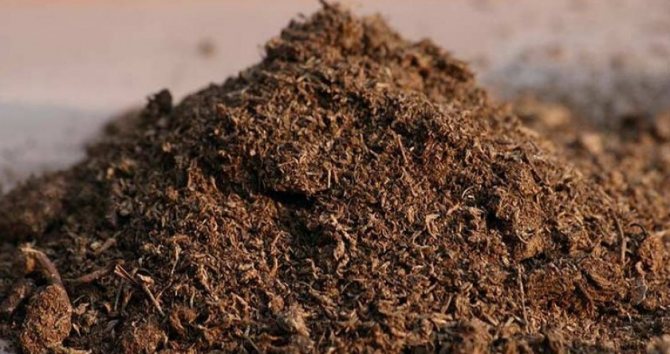

Planting land preparation and fertilization
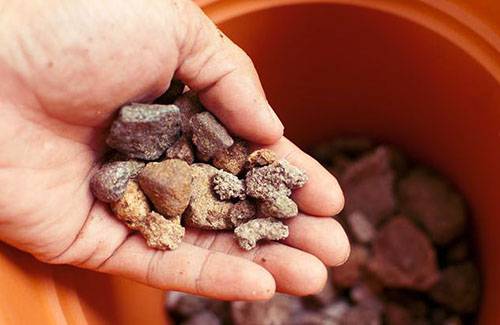

The main requirement for the substrate is that it should be light, breathable and with little acidity. ounce for anthurium should have the properties of absorbing moisture, but not retaining excess moisture. There are special formulations that you can buy. One of them is Seramis clay granulate, which is a completely ready-made substrate. In others, even ready-made mixtures "Azalea" or "Saintpaulia", you need to add crushed bark, charcoal, coconut fiber or sphagnum moss, vermiculite and brick chips. If the composition is prepared independently, then the mixture is taken as a basis in equal proportions:
- top peat;
- leaf humus;
- sand;
- sod land with the addition of vermicompost.
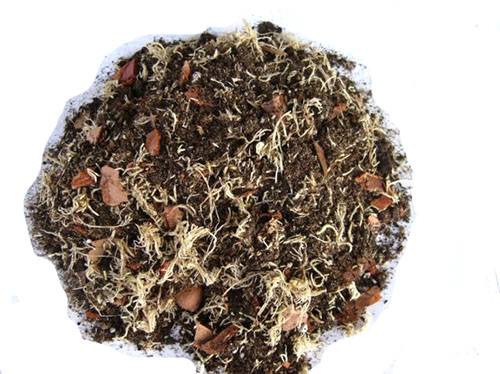

In this case, the soil for anthurium is completely steamed and treated with a strong solution of potassium permanganate. After that, it is dried to a free-flowing state, but with residual moisture. Expanded clay is used for the drainage layer, which is also subjected to disinfection. When planting a plant, the soil is not compacted or excessively moisturized. The roots must breathe. Deepen the plant to the neck. Over time, the roots show up on the surface. To keep them from drying out, there should be a fibrous material in the form of moss or coconut fiber on top. Vermiculite is also suitable.
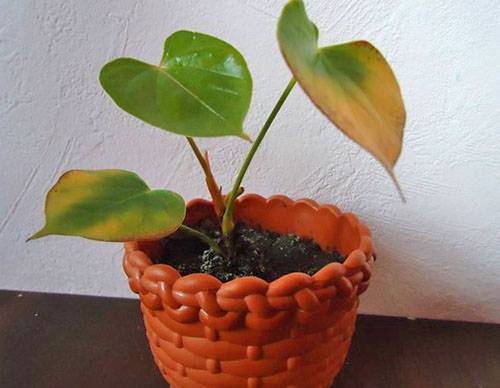

Since the soil is not particularly nutritious, then a month after transplanting the plant must be fed. During the growth period, extracts from organic or special fertilizers for anthurium, ornamental flowering plants, and aroid are added to the irrigation water.
Anthuriums often suffer from excessive care. Everything in moderation. Fertilizers in a half dose of that indicated on the package. Watering when the top layer dries and in small portions. The drip tray with dampening materials should not stand directly under the drain hole without a gap.
Selection of ready-made soil
If you decided to buy soil in the store, but did not find it specifically for anthurium, substrates "Polessky", "ForPro", a mixture for growing all plants of the aroid family - "Auriki's Gardens", mixtures for orchids are suitable. Their composition, in most of the components, has something in common - peat, bark, coal, coconut, moss, perlite, sand.
Pros of purchased soil:
- getting a finished substrate without hassle;
- balance and exposure of proportions;
- treatment for diseases and pests.
Cons of the finished mixture:
- a mixture of different qualities;
- the size of the components may be too small or too large;
- the substrate may be too acidic, moisture-absorbing, or, conversely, moisture-repellent;
- high price;
- difficult to buy for a particular plant.


On a note
Anthurium purchased in the store should be transplanted, because the substrate in which it is planted is designed to retain moisture, consists of peat and coconut fiber. In the future, it will be difficult to monitor watering. The top layer looks dry, but there is still enough moisture inside. As a result of waterlogging of the soil, anthurium will suffer.
Anthurium cannot be called a very capricious plant, but just like a Tradescantia herb, it will not grow and bloom. It needs a special approach - special soil, moderate watering, good lighting.
What kind of drainage is needed for growing?
The health and beauty of anthurium depends on the presence of drainagebecause these plants do not tolerate stagnant water in the root system and may die. To create optimal conditions for flower growth, you need to think about good drainage, only in this case excess water will go away and the roots will breathe.
It's important to know! Good drainage for flowers should be chemically inert, allow water to pass through, and not mold or rot.
Such materials are suitable for preparing drainage.:
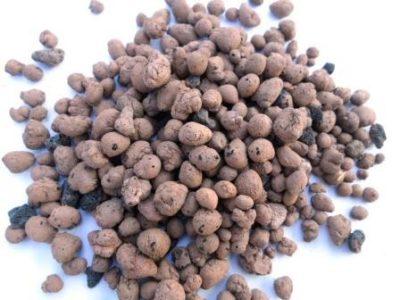

clay shards;- broken brick;
- expanded clay;
- gravel;
- crushed stone;
- Styrofoam.
The most expanded clay is a popular material for drainage, it is able to absorb excess moisture... These are burnt pieces of clay that have a porous structure. You can buy it at flower shops.
When using other materials as drainage, the following tips should be followed:
- when using clay shards as drainage, the pieces should not be allowed to be too large, since sand should be poured on top of them, and it should not spill down;
- broken brick should not have sharp edges, so as not to damage the roots of the plant, it must also be borne in mind that silicate brick is more suitable than red, as it absorbs moisture, and then gives it back as it dries;
- Styrofoam is a good drainage material, but it has one drawback: the roots of the plant grow into its structure and when a flower is transplanted, they can be accidentally damaged.
When creating high-quality drainage, the anthurium will be guaranteed comfort, it will grow, develop and bloom well.
Signs of improperly selected land
A substrate that does not meet the requirements of the plant can lead to diseases, wilting and even death of the plant. In most cases, it signals inappropriate growing conditions.
This is manifested:
- growth retardation;
- lack of flowering or its sudden cessation;
- uneven development of the stem and leaves;
- wilting of leaves;
- drying out of the plant, regardless of watering.
Competently selected soil is the key to good growth and development of anthurium, which for many years will delight with beautiful foliage and wonderful flowers in response to care.
Is it possible to plant "male happiness" in a container from under another plant?
Some plants in the process of life release substances that inhibit the growth of other plants. It is impossible to know in advance whether the soil left over from the predecessor is "poisoned" for anthurium. The remains of this soil and, most importantly, substances released by the former inhabitant of the pot can remain on the walls of the pot and harm the new plant.
If it is a pity to throw the pot away, then before planting another plant in it, it is necessary to thoroughly wash both the inner and outer surfaces from soil residues, and then be sure to disinfect. For disinfection, you can use a solution of potassium permanganate of dark pink color.
Plastic pots are usually not so expensive that, for the sake of small savings, they risk ruining such a handsome man as anthurium.
"Man's Happiness" is a magnificent interior decoration. With the right attitude, this flower will bloom profusely for years and delight the hosts and guests.
Frequently asked questions about anthurium
1. What should you pay attention to when growing Anthurium?
Answer: Anthuriums are kept at a temperature of at least 18 degrees in conditions of high air humidity (daily spraying is necessary). Photophilous. The soil temperature cannot be lower than the ambient temperature, so it is better to use plastic, not ceramic pots. Anthurium consumes a lot of water, so the soil should not be allowed to dry out. Anthurium Andre tolerates the sun better than Scherzer's anthurium, but it is better to darken it, in bright light it feels normal, but without the sun too, and better in a humid atmosphere. When spraying, try not to get large drops of water on the flowers - ugly spots will remain.
2. How to divide anthurium?
Answer: Very carefully! When dividing, the roots must be carefully untangled or cut with a knife. You can spill a little epin or root.
3. The plant requires transplanting, but it is recommended to transplant only in spring, what should I do?
Answer: It is best to do now the transfer to the pot a little more than before, and carefully change the topsoil, without exposing the roots, if possible. Good drainage and very loose soil are required. If there are aerial roots, lightly dust them with the same soil or cover with damp moss.
4. Yellow spots on the leaves appeared on Anthurium. Why does this happen, from hard water or from overfeeding with fertilizers?
Answer: If the spots are large - evenly over the entire surface of the leaf, and the leaves themselves are either less than the previous ones, or more - then these are clear signs of unbalanced fertilization. If the specks are small and visible in the light, then perhaps this is a spider mite.
5. Can blooming anthurium be transplanted?
Answer: Blooming flowers can not be transplanted, but only transshipped, i.e. without damaging the earthy coma, especially if the pot is small. And put the flower in a bright place.
6. How deep the roots can be buried during transplantation
Answer: They can and should be buried during transplantation, well, of course, you should not be zealous. The roots must definitely be covered. If you cannot deepen it, cover them with at least sphagnum. In anthuriums, even aerial roots are recommended to be wrapped in moist sphagnum ...
7. Anthurium does not bloom!
Answer: The path to success with anthuriums is this: in order for it to bloom, it must be at a temperature of at least 18 degrees around the clock, it does not like direct sunlight, it needs diffused light. Watering is moderate, he really does not like drafts. His pot must be slightly larger than his root system, otherwise it will not bloom! And, of course, light fertilization once a week.
Do I need to transplant the purchased anthurium
Before purchasing an anthurium home plant, you must familiarize yourself with the care requirements. If there is spathiphyllum in the house, then flower care is similar. For anthurium, vital indicators will be a constant temperature of 21-24 in summer, not lower than 18 in winter. In addition, there are special requirements:
- complex composition of the earth;
- the shape and size of the pot;
- quality of irrigation water and fertilizer;
- air humidity;
- lack of drafts.
The beauty of a flower depends on healthy leaves and abundant flowering. The slightest deviations in care will lead to a loss of decorativeness.
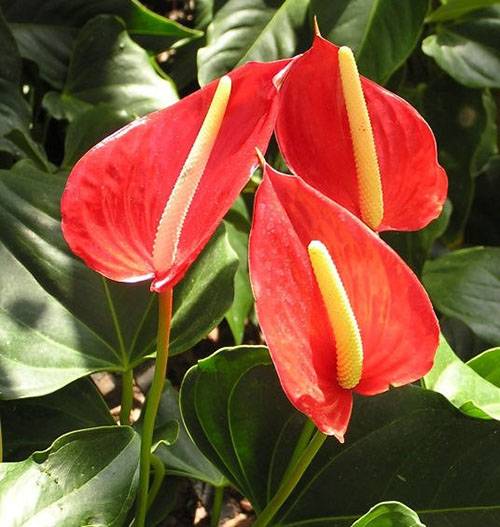

So, a new pet appeared in the house. First of all, he must go through quarantine, that is, he must live separately from other flowers for two weeks. The best place for this period may be the bathroom. It is warm and humid there, and the backlighting is not difficult to organize. During this time, diseases and pests will come to light, if any. Watering anthurium during this period should be poor.
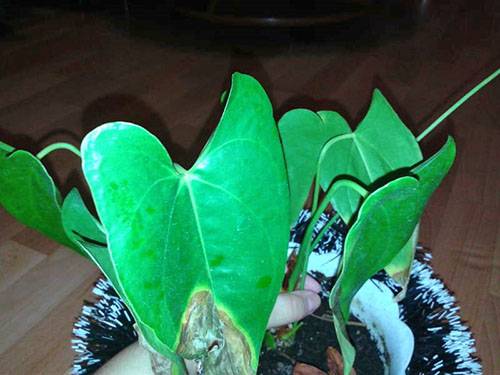

Anthurium is a poisonous plant with a caustic sap.Therefore, he must be out of reach of children and animals. Leaving with pruning and replanting should only be carried out with protective goggles and gloves.
In the future, if everything is in order, you will need to transplant or reload the plant. It should be borne in mind that the roots of anthurium are very fragile, and transplantation will invariably lead to injuries. Therefore, it is better to transfer the plant to a new pot and add earth around the edges without compaction. Choose a pot for anthurium with a smooth inner surface, slightly larger than the previous dishes. The roots should receive more nutrition, but a pot that is too spacious will prevent flowering. Until the container is filled with roots, the anthurium will not bloom. Therefore, you do not need to take a pot "for growth". Better to buy a plastic container, it is warmer.
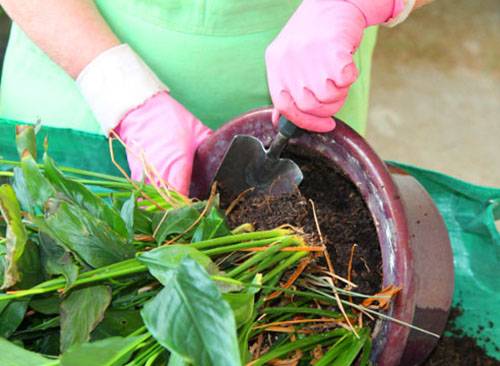

Recommendations to completely change the soil in the flower relate to cases when there is a suspicion of root disease or overflow is allowed. The plant gives a signal with spots on the leaves that there is a disorder with the roots. Then the plant is not only freed from the old soil, but the roots are carefully washed, dried and all questionable areas are cut out.
Agricultural technology in winter
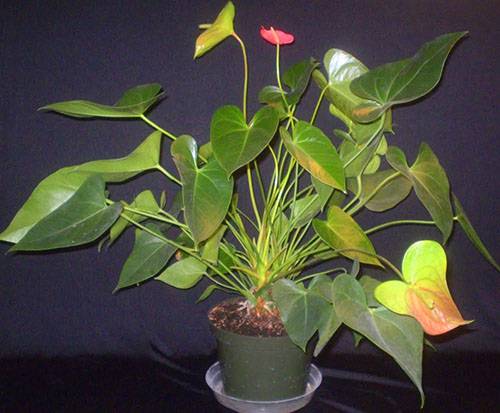

All aroids, including anthurium, have a dormant period in winter. All life processes slow down at this time. Therefore, the air temperature should be lowered to 18 degrees, but at 15 the plant will freeze. A signal that the roots are cold will be the appearance of brown spots or a completely brown leaf. Then you need to slightly warm up the legs of the plant.
Daylight hours should be about 10 hours. Therefore, supplementary lighting in regions close to the Arctic will be useful in winter. There is only 6 hours of daylight in December. Watering in winter is reduced the more, the lower the temperature, but the complete drying of the clod of earth should not be allowed. With excessive moisture, root rot is inevitable.
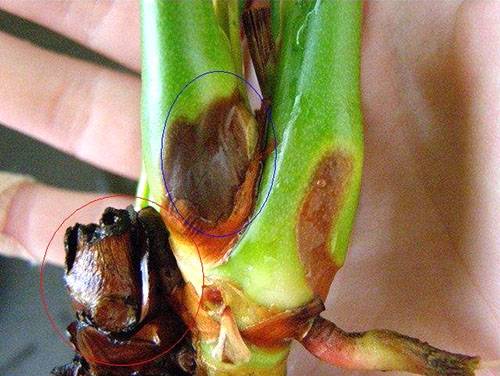

Spraying anthurium in winter is rarely done, once a week. In this case, you should constantly remove dust from the leaves with a wet cloth. Appearing yellow spots are a signal of insufficient lighting. Brown spots in the middle of the leaf indicate cold content. Drying leaf edges signal dry air. In addition, you need to examine the plant for colonization with scale insects, aphids, thrips.
Anthurium should not be transplanted in winter, you need to wait for its awakening. But if it has been poured, and the situation is emergency, then you can try when it’s not enough to reach the spring. In winter, the survival rate of the atrium is low.
Pot


The container for anthurium should be chosen low and wide, with a hole for the outflow of water. Its roots grow well in breadth, but they penetrate shallowly into the ground. Planting in a tall pot will cause souring of the uncultivated land by the plant and cause putrefactive processes. You can take a container of any volume and fill it with drainage not by 1/4, but almost completely, leaving room for the substrate and flower.
The pot should be plastic or unglazed clay. Otherwise, enough oxygen will not be supplied to the roots, and the plant will be constantly depressed. In order not to spoil the interior, the container can be placed in a beautiful planter.
A slightly cramped pot promotes the formation of peduncles, a spacious one - the growth of many children.
Inspect Anthurium Roots upon Purchase


When buying a new anthurium flower, you should definitely examine its roots. Remember lightly the walls of the plastic pot and gently pull out the root ball of earth.
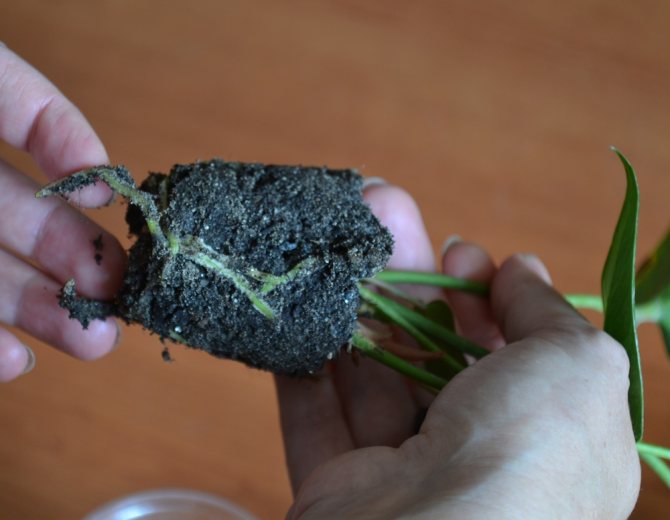

The roots of the plant should be light and dry, and the ground should be moist and loose.
Some of the roots of the anthurium, as well as those of the orchid, are found not only in the ground, but also in the air. If you bought an adult anthurium, you can find them on the surface of the ground. You do not need to cover them with soil, this is the natural state of the plant.
What should be the composition of the soil?
Anthurium roots are similar to orchid roots, therefore they have the same soil requirements - sufficient moisture and oxygen access.
The composition of the substrate should include three main components:
Otherwise, you can improvise by adding other components to the mixture:
- peat;
- land (leaf);
- river sand;
- pine bark;
- small stones;
- expanded clay.
It is also useful to add mineral elements - vermiculite or perlite. In the natural environment, anthuriums grow in forest litter, tree bark, foliage and other forest debris. Therefore, when growing a flower at home, you need to try to imitate the same conditions.
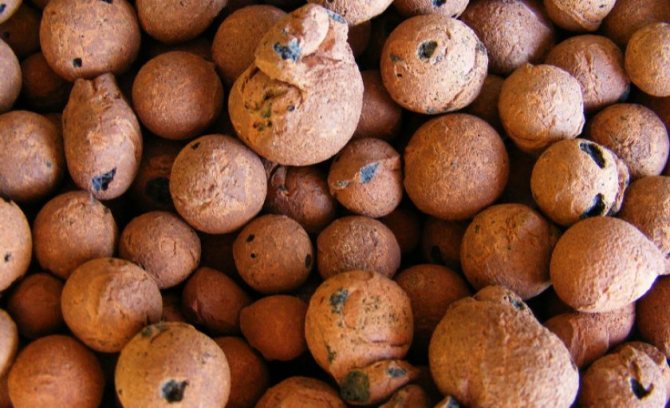

Possible mistakes
Sometimes, when a plant is transplanted incorrectly, problems arise that must be solved in the near future, because they can lead to death.
| Transplant error | Solution of the problem |
| When transplanting, they took too large a pot | With such an error, the flower will not bloom for a long time. It is necessary to pick up a smaller pot and replant it. |
| With the wrong soil, the flower will not throw out the flower arrows. | Transplant the flower into an appropriate soil. The soil should be light and fertile, consisting not only of peat alone. |
| Leaves turn black after watering. | Watering is done with warm and settled water, allowing the earth to dry out between waterings. If mold has formed in the pot from excessive watering, it must be transplanted and at the same time the decaying parts of the root system must be removed. |
Important! If there are doubts about the correctness of the transplant, it is necessary to study the material again so as not to bring the flower to death.
Photo
In the photo you can see what containers the flower "male happiness" loves and what the pot should be for it.
What land is suitable for anthurium


When transplanting anthurium, you need to use a special soil consisting of several components. Such a soil can be bought ready-made in a flower shop, a substrate intended for orchids. But you can prepare such a soil yourself. First, find this wide, free container for mixing soil.


These are the four components that make up the soil for anthuriums. Peat, pine bark, sphagnum moss and perlite. Let's take a closer look at the proportions of these components and a detailed description of each of them.
Time to spend
Anthurium needs nutritious soil during its growth. Therefore, young, fast-growing plants are replanted every spring.
After 4 years of age, the growth rate of the plant decreases markedly. Adult plants are transplanted much less often - once every 3 years.
Best of all, anthurium tolerates a transplant in spring.... It must be remembered that any transplant is stressful for the plant, especially for such a capricious one as anthurium. Therefore, a flower transplanted in early April will have time to take root in a new pot and bloom by summer.
Soil requirements
In the natural environment, representatives of the species are able to grow in various soils, up to clay and sandy loam. But ornamental houseplants are demanding on the composition and consistency of the soil. For indoor plants, it is necessary to ensure good air permeability of the substrate, as well as porosity and drainage. The soil must retain moisture.
For drainage, almost half of the tank is filled with: coconut shells, expanded clay, wood bark and coal, shingles, stones. The size of the fraction (part) of each component is 2 cm, with the exception of tree bark, parts of which can reach 5 cm.
The soil should have the following properties:
- looseness;
- lack of caking;
- the presence of air pockets;
- lack of ability to seal;
- slightly acidic reaction - pH 5.5–6.5.
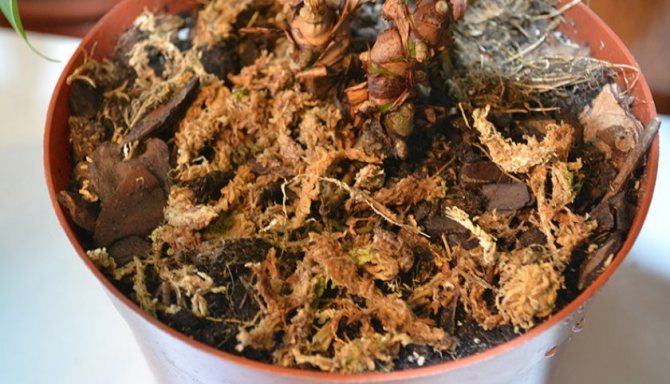

Drainage and sphagnum moss
The right substrate is not everything.
So that the irrigation water does not stagnate in the pot and does not cause root rot, a drainage layer is poured onto the bottom of the pot - expanded clay. It is desirable to have a coarse fraction to form air pockets.Anthurium roots love to breathe! In addition, expanded clay acidifies the soil, making it more suitable for anthurium.
After planting, a small layer of sphagnum moss is spread on the surface of the soil to close the aerial roots. Moss should be kept moist by spraying it regularly.
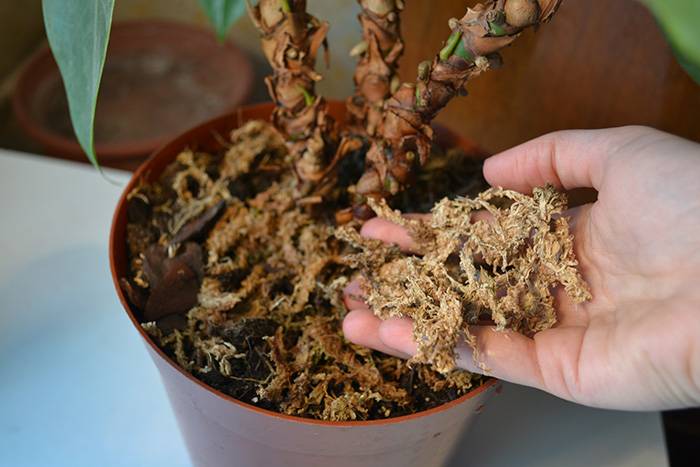

Sphagnum moss is used to maintain moisture in the aerial roots of anthurium.
It is worth noting that the correct choice of soil for anthurium will save your flower from many problems, such as rotting roots due to stagnant water and lack of air, lack of flowering, growth retardation.
cvetok-v-
Store soil for anthurium: can you buy it?
If you do not want to compose the soil yourself, you can try to buy it. Unfortunately, this can be difficult. Few manufacturers produce specialized soil for anthuriums.
But, nevertheless, there is a small selection:
Some soils for orchids with a similar composition (based on peat and bark) are also good for anthuriums. For example, we read the composition of a set of substrate components for orchids from "Auriki's Gardens": peat, bark and pine needles, charcoal, biohumus, sphagnum. Isn't it a soil for anthurium?
The only thing that can be added to such a substrate is a universal soil. To adjust the mixture towards the correct ratio of bark and peat soil (1: 1).
What capacity does a flower need?
Anthurium feels best in a humid tropical forest, therefore, for its prosperity, it is necessary to create similar living conditions for it. It is necessary to take care of the temperature regime, composition and sufficient moisture content of the soil and, perhaps most importantly, the size and shape of its "house". Surprisingly, the material and size of the pot is just as, if not more, important than the properties of the environment and the composition of the soil.
The red tongue loves loose soil rich in oxygen. Like many tropical plants, it grows on a rather large substrate. Its roots grow mostly parallel to the surface, not inward. Therefore, a shallow, wide container is better suited to it. It will help the roots of the plant to develop naturally.
What kind of pot can provide the most suitable conditions for the growth and prosperity of anthurium?
How to choose the size?
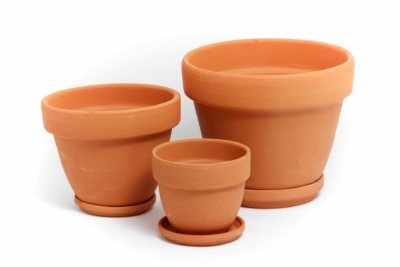

The size of the pot depends on the goal you want to achieve.
- If you want your plant to bloom profusely, plant it "back to back": so that from roots to walls it is only 1-2 centimeters.
- If you want the anthurium to grow and throw out the "kids", then the pot should be made wider than the root system by 4-5 centimeters. In this case, the green mass will grow, and the flowers will become somewhat less.
As the anthurium grows, the size of the pot should be increased. For the first 2-3 years, the plant must be replanted every year, expanding the pot by 1-2 centimeters. Later, the interval between transplants can be extended to 2-3 years. The size of the pot when transplanting an adult plant increases by 3-4 centimeters.
An indication that the time for replanting is approaching is the "creeping" of roots through the drainage holes and overgrowth of aerial roots on the soil surface.
What's the best material?
Often used in home floriculture ceramic pots are not very suitable for growing anthurium. Their walls allow evaporating moisture to pass through and cool, which disrupts the temperature regime of the underground part of the plant.
In addition, the roots tend to grow into the pores of the ceramics. Because of this, they will inevitably be damaged during the next transplant. Sometimes ceramic containers are used, glazed from the inside. They do not allow roots to grow into the walls, but they do not solve the problem with the temperature regime.
Plastic containers are more suitable for the "red tongue" but they also require additional attention. Dense walls exclude water evaporation and excessive cooling of the roots.However, in a plastic pot, irrigation water can stagnate, and excess moisture for anthurium is even worse than short-term drying.
The bottom of the outer pot is filled with expanded clay or brick chips drainage. The bottom of the inner pot is separated from the water by an air gap, which does not impede the passage of water and air, but prevents sudden temperature fluctuations.
The form


The shape of the pot does not affect the growth and development of the anthurium. It is worth paying attention only to the fact that the vessel is not too deep (this can lead to caking of the soil) or, conversely, too flat so that the water does not stagnate. The optimal height of the pot is 3-5 centimeters less than the diameter.
It is worth noting that anthurium feels great inside glass showcases, in which you can create the most favorable conditions for it in terms of temperature, humidity and illumination. While this does not apply to the shape of the pot, it is worth keeping this in mind when planning your home garden.
Holes in the bottom
For the successful cultivation of anthurium, there should be enough drainage holes in the bottom of the container through which excess water is drained during watering. The air necessary for the roots enters through the same holes.
In nature, anthurium grows on the forest floor, from which it receives food, water and air. Therefore, the substrate for its cultivation must be loose and not hygroscopic (do not accumulate water). For a "red tongue", not a wet, but a moist substrate is optimal. Excess water must necessarily drain into the pan, otherwise the roots may rot, and the plant may die.

